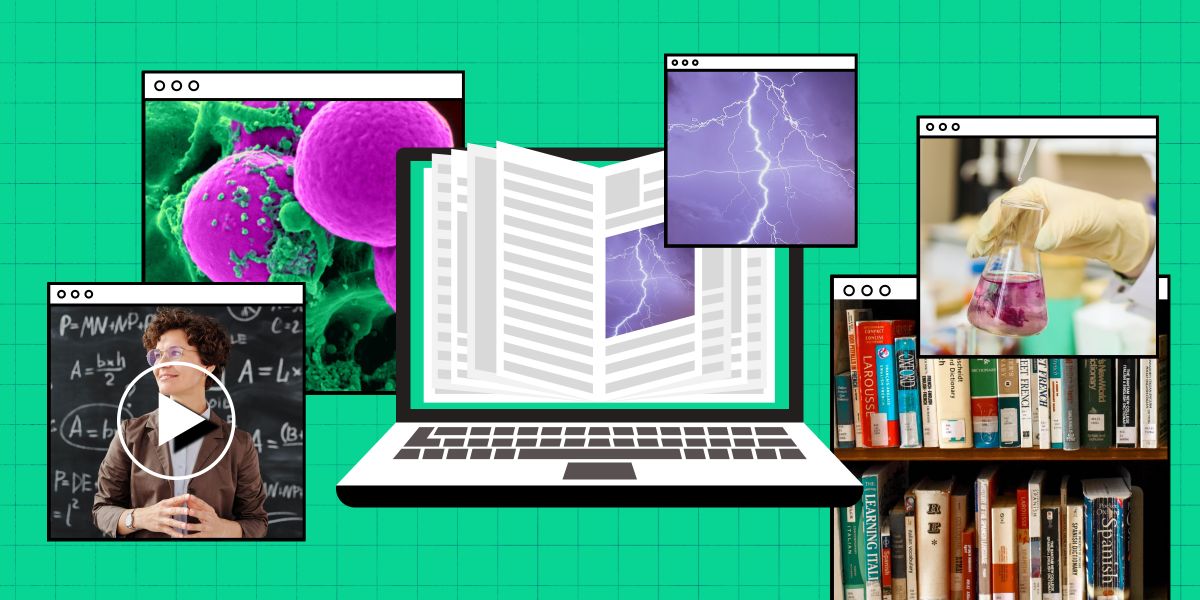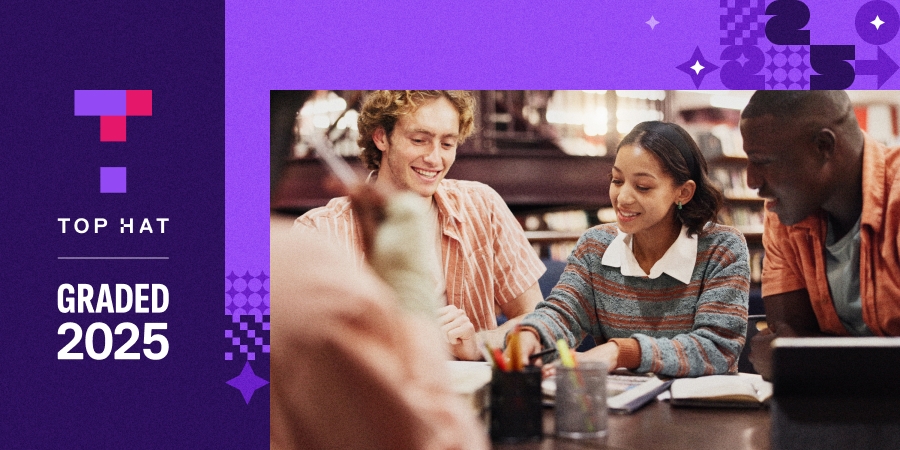In today’s online learning landscape, traditional textbooks just aren’t getting the job done. Not only are they hard to access physically while off campus, they’re overpriced and often contain outdated information. Open Educational Resources (OER) can be more widely adopted in online, in-person and hybrid classes due to their flexibility, minimal costs and easy access. Below, we outline why universities and professors should consider making the transition to OER—and why traditional textbooks are on the way out.
Index
- What is OER?
- How is OER used in education?
- Why is OER important?
- OER textbook initiatives across the country
- Why should you choose OER?
- Low or no cost
- Flexibility and scalability
- Publicity
- OER grant programs
- The drawbacks of OER
- Quality
- No built-in interactivity
- Updatability issues
- What is the future of OER?
- The rise of digital textbooks
- Top Hat textbooks offer a flexible learning solution
- References
What is OER?
Open Educational Resources (OER) are research materials stored in the public domain. OER course materials are released under an open license that grants users free use and redistribution.1 In 1997, California State University created MERLOT to provide students with mostly free, open source materials for higher education. Four years later, David Wiley, Assistant Professor at Utah State University, proposed a license for free and open content to eliminate copyrighted material. As Open Access gained traction it led to the rise of the Public Library of Science (PLOS)—one of the largest databases currently holding 11,000+ open journals.2 Creative Commons is a nonprofit that helps overcome legal obstacles when sharing knowledge online. Unlike this organization, which boasts more than 1.1B open resources for free use, text in Wikipedia is copyrighted and is under several international licenses.
How is OER used in education?
OER increases access to education and offers readily available resources for self-directed or just-in-time teaching. OER awareness shows steady growth year-over-year. In a report by WCET and Bay View Analytics, 26 percent of educators knew what OER was in 2014–2015, whereas in 2018–2019, nearly 50 percent of educators were aware of OER.3 There are five key points that govern Creative Commons licenses. Here are what the “5 Rs” of OER mean in higher education.4
| Principle | Definition |
| Reuse | The right to use content in a variety of ways such as in class or repurposing content in a video or on a website |
| Retain | The right to make, own and control copies of the content via downloading, for example |
| Revise | The right to adapt, modify or alter the content such as translating it into another language |
| Remix | The right to combine the original content with new course material to create something new—such as an audio mashup |
| Redistribute | The right to share copies of the original content with others |
In the same report, the challenges associated with OER are explored. Roughly half of educators believed that there was not enough open content for their subject while 30 percent of respondents expressed concern over the quality and ability to update material (more on this below). That said, OER is more widely adopted at colleges nationwide. Traditional publishing companies such as Cengage tweak their offerings to incorporate OER-based materials—which include free e-textbooks from sources like OpenStax—into their portfolios.5
Why is OER important?
Textbook costs have ballooned over the past decade. Students have had enough and have fought for open access course content. The Ontario Undergraduate Student Association (OUSA) started the #TextbookBroke campaign, an initiative which highlights current courseware costs for students.6 Financial strains that have come as a result of COVID-19 have made it even more important for students to learn anytime and anywhere—at a fraction of the cost of traditional books. The benefits of open resources for students are three-fold:
- Students don’t have to purchase expensive materials
- Students can access these resources on their own time
- Books stored in the public domain offer free, online alternatives7
OER textbook initiatives across the country
OER textbooks are at the heart of OpenStax—Rice University’s initiative which publishes high-quality, openly licensed courseware for free online use.8 OER Commons Hub and the William and Flora Hewlett Foundation also distribute open learning materials for students. OER Commons Hub allows groups to design Hubs which meet target audience needs9 and the Hewlett Foundation collaborates with content producers and policy groups to support the adoption of an OER ecosystem.10
Why should you choose OER?
Low or no cost
Educators who use OER instead of traditional courseware can help students save big. Students in Ontario, Canada have already saved $1.7M11 and due to minimal costs, students can take full course loads without being overwhelmed with financial woes. In the United States, 65 percent of students skip buying the assigned textbook because it’s unaffordable.7 Data from 600 courses at 120 U.S. institutions show how the average price for traditional materials in one course is $134 while a course using open courseware costs $17. Students are therefore able to save up to $11712 per each course that adopts open textbooks.
In the United States, 65 percent of students skip buying the assigned textbook because it’s unaffordable.
Flexibility and scalability
OER provide extensive scalability which allow platforms to distribute open materials at a rapid pace. Open textbooks can also be used to reflect changes in subject matter—even more necessary in a continually evolving economic, political and social world due to COVID-19. Educators can use an existing OER and adapt it to their lectures and can engage students through multimedia versus plain text.13
City University of New York (CUNY) and the State University of New York (SUNY) are the recipients of Governor Andrew Cuomo’s $8M investment towards mitigating the unreasonable cost of traditional courseware. Cuomo’s investment works in favor of adopting OER and exploring Z-degrees—programs without any textbook fees.14 Free and open source materials can be contextualized to a specific course since OER permits flexibility to revise existing content, add new content, and combine parts of resources together without the burden of copyright regulations or intellectual property licenses.15
Publicity
Due to the nature of open textbooks, OER enable professors to showcase their research interests to audiences beyond their course or semester-specific cohort. Publicly accessible courseware can provide benefits not just for current students and professors but also for alumni. These readily available learning materials enable graduates to engage in an ongoing cycle of lifelong learning.14
OER grant programs
States such as Maryland, Massachusetts and North Dakota offer OER grant programs to support faculty adoption and to help students save. Foundations such as the Hewlett Foundation also invest in OER to improve access to education, personalized learning and student success among underserved learners. Others like the Bill and Melinda Gates Foundation have invested in OER infrastructure and technology. The result? More OER use in courses with high enrollment numbers.3
Top Hat’s Catalog offers free or low-cost, high-quality and engaging course materials for any discipline. Explore the Catalog here.
The drawbacks of OER
Some professors at leading institutions hesitate to adopt OER in their classrooms. Here are some commonly viewed disadvantages of OER, along with some helpful workarounds.
Quality
How can professors ensure their students receive the most accurate, reliable information from sources which are constantly being adapted? It’s important to fact-check suspicious teaching materials and incorporate peer-reviewed courseware wherever possible, as exists in Open Textbook, MERLOT and content found in the Top Hat Catalog. All three sources incorporate OER assessments to gauge whether an e-textbook is peer-reviewed. Rubrics can also be a good indicator of an open source’s integrity—they’re designed to improve accountability and can show how near or far an OER aligns with Common Core State Standards.16
No built-in interactivity
Storing open source materials in an institution’s digital repository or on a campus website aren’t the most interactive and sustainable options in the long-run. Housing open content on a specific platform limits its accessibility since it becomes static and limited to specific audiences. However, Creative Commons is an effective alternative for ensuring that multiple audiences can interact with open content. Under the Creative Commons Attribution 4.0—the most updated license guidelines—you may share and adapt content freely, as long as appropriate credit is given to the originator.
Updatability issues
Repurposing content has its downsides, namely, outdated educational materials. It can be a challenge for professors to recognize which version of a digital textbook is the newest one and which ones are outdated at first glance. Equity issues may arise for schools within the same district who opt to use a different version of the proposed courseware17 and so it’s key to ensure the quality of open source material is as precise as need be. Please refer to the “Quality” section above for tips on how to evaluate open learning options for your course.
What is the future of OER?
The future of higher education may be facilitated predominantly by OER—as the CARE framework shows. Proposed by Lisa Petrides, Douglas Levin and C. Edward Watson, this framework comes with four pillars: contribute, attribute, release and empower. CARE is designed to diversify stakeholders of OER, promote OER adoption and advocates for student success through greater access, equity and affordability. OER stewards work to put the CARE framework into practice in the following ways.
- Contribute: Stewards must actively contribute to efforts which raise awareness and distribution of OER
- Attribute: Stewards must practice conspicuous attribution to ensure credit is given where it’s due
- Release: Stewards must ensure OER can be released beyond the platform in which it is created and delivered
- Empower: Stewards must empower and support non-traditional voices in the creation and adoption process of open content18
Postsecondary institutions are praised for their efforts to move towards innovative pedagogies like OER. In 2018, the U.S. Education Department awarded $4.9M in OER funding to a STEM-based open courseware initiative out of the University of California, Davis. UC Davis also partners with 11 other U.S. institutions who have the same mission.19 The Open Textbook Pilot is another U.S. federal grant program that supports projects at postsecondary institutions which advocate for open textbooks. The Open Textbook Pilot was recently renewed for another $7M in 2021.20
The rise of digital textbooks
COVID-19 has made it even more necessary for educators to abandon traditional textbooks. Some college libraries21 are now being forced to quarantine print textbooks—making it a challenge for students to readily access their course materials. Digital textbooks let students access their coursework from anywhere, some of which can even be viewed without an Internet connection.
Thought leaders in higher ed also see digital books as the way of the future. For instance, Bill and Melinda Gates’ annual letter from 2019 depicts the standalone college textbook as “a thing of the past.”22 Traditional textbooks aren’t readily accessible, aren’t dynamic and most importantly, come with a hefty price tag. Students won’t be willing to fork over hundreds at a time for courseware—especially during a global pandemic.
Bill and Melinda Gates’ annual letter from 2019 depicts the standalone college textbook as “a thing of the past.”
Top Hat textbooks offer a flexible learning solution
Top Hat’s online bookstore offers affordable and interactive alternatives to traditional print books. Customize any textbook to suit the needs of your students and your course. Take advantage of embedded simulations, multimedia and diagrams or add your own to any textbook. Plus, use discussion questions to ensure students understand core concepts. Access hundreds of interactive titles in the Catalog from bluedoor Publishing, Fountainhead Press, Nelson Education and more.
Are you teaching a niche course or looking to further personalize the learning experience? Bring your dream textbook to life through Top Hat’s authoring tools. Katie Thompson-Laswell, Senior Instructor of Human Development and Family Science at Kansas State University, struggled with engaging her 200+ students in and out of class. Her solution was authoring her own book titled Introduction to Human Development, which not only engaged her large classes but helped save students $70 on course materials.23
Create a textbook that your students won’t want to put down. Learn more about Top Hat’s authoring capabilities here.
References
- Open Educational Resources (OER). (2018, October 23). UNESCO. https://en.unesco.org/themes/building-knowledge-societies/oer
- Bliss, T.J. and Smith, M. (2017). A Brief History of Open Educational Resources. In: Jhangiani, R S and Biswas-Diener, R. (eds.) Open: The Philosophy and Practices that are Revolutionizing Education and Science (pp. 9–27). London: Ubiquity Press. doi:https://doi.org/10.5334/bbc.b.
- The Impact of OER Initiatives on Faculty Selection of Classroom Materials. (2020). WCET and Bay View Analytics. http://www.onlinelearningsurvey.com/reports/impactofoerinitiatives.pdf
- The 5 Rs of Using OER. (n.d.). Nova Southeastern University. https://nsufl.libguides.com/oer/5rs
- McMurtrie, B. (2017, December 19). Use of Free Textbooks Is Rising, but Barriers Remain. The Chronicle of Higher Education. https://www.chronicle.com/article/Use-of-Free-Textbooks-Is/242086
- Joseph, A. (2018, October 1). #TextbookBroke Campaign Highlights Cost of College Textbooks. [Blog post]. https://tophat.com/blog/textbookbroke-campaign-college-textbooks/
- Report: Make Higher Education Affordable. (2014, January 27). U.S. PIRG. https://uspirg.org/reports/usp/fixing-broken-textbook-market
- Who we are. (n.d.). OpenStax. https://openstax.org/about
- What is an OER Commons Hub? (n.d.). OER Commons. https://www.oercommons.org/about-hubs
- Open Education. (2016, August 03). William + Flora Hewlett Foundation. https://hewlett.org/strategy/open-education/
- #TextbookBroke. (n.d.). Ontario Undergraduate Student Alliance (OUSA). https://www.ousa.ca/textbookbroke
- Nyamweya, M. (2018, December 20). A New Method for Estimating OER Savings. SPARC. https://sparcopen.org/news/2018/estimating-oer-student-savings/
- Benefits of Using OER. (n.d.). Penn State. https://oer.psu.edu/benefits-of-using-oer/
- Pasela, S. (2019, January 11). Open Education Resource Initiative Reports Success. CUNY University Faculty Senate. https://www1.cuny.edu/sites/cunyufs/2019/01/11/open-education-resource-initiative-reports-success/
- Step One: What Are OER, Why Are They Important, and What are the Barriers to Adoption? (n.d.). BC Campus. https://opentextbc.ca/studenttoolkit/chapter/step-one-what-are-oer/
- Himmelsbach, V. (2017, November 21). Tips for Finding Good OER Content for Your Course. [Blog post]. https://tophat.com/blog/find-good-oer-content-tips/
- Sparks, S. D. (2017, March 28). What Is OER? Answers to 5 Questions About Open Educational Resources. Education Week. https://www.edweek.org/ew/articles/2017/03/29/what-is-oer-5-questions-about-open-oer.html
- Petrides, L., Levin, D., & Watson, C. (2018, March 4). Toward a Sustainable OER Ecosystem: The Case for OER Stewardship. The CARE Framework. https://careframework.org/
- Lieberman, M. (2018, October 2). Single Project Earns Federal OER Pilot Grant. Inside Higher Ed. https://www.insidehighered.com/digital-learning/article/2018/10/02/department-education-awards-pilot-oer-grant-uc-davis-open
- Open Textbook Pilot Grant Program. (n.d.). SPARC. https://sparcopen.org/our-work/open-textbook-pilot/
- McKenzie, L. (2020, October 13). Textbooks in Short Supply Amid COVID Quarantines. Inside Higher Ed. https://www.insidehighered.com/news/2020/10/13/covid-19-forces-college-libraries-quarantine-textbooks-hitting-low-income-students
- Gates, B., & Gates, M. (2019, February 12). Our 2019 Annual Letter. We didn’t see this coming. GatesNotes. https://www.gatesnotes.com/2019-Annual-Letter
- How an interactive Top Hat textbook helped this professor succeed in the move to remote learning. (2020). Top Hat. https://tophat.com/customer-stories/kansas-state-university/


